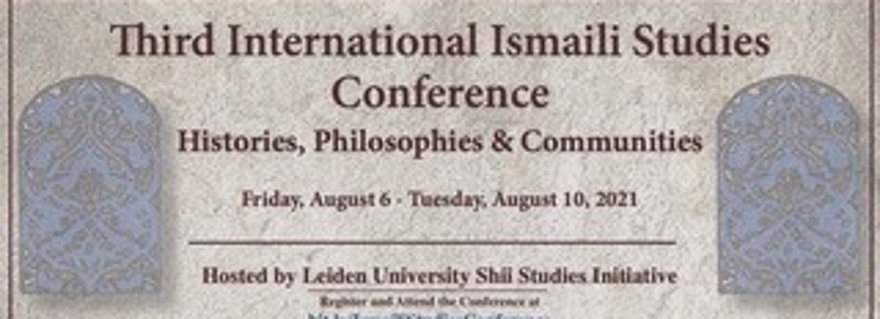.
Presentations
Ḥikāyat-i Sayyid Nāṣir-i Khusraw
The Ḥikāyat-i Sayyid Nāṣir-i Khusraw is a newly discovered treatise, possibly written between 541-557/1147-1162, which illuminates the perspectives of a subaltern group persecuted by the Nizari Ismaili hierarchy for their agitation to bring about the manifestation (ẓuhūr) of their imām. Ismailis in Iran awaited the manifestation of a descendant of Nizār b. al-Mustanṣir who was killed in Cairo in 488/1095 after a failed attempt to succeed his father as the Fatimid imām-caliph. In 559/1164, the fourth ruler of the Nizari polity, proclaimed the Qiyāmat-i buzurg (the Great Resurrection) and was subsequently recognised as the Nizari imām. This text records how its author construed the transference of imamate from Egypt to Iran. It structured continuities between the Fatimid and Nizari daʿwa (summons) and between communities of followers of Nāṣir-i Khusraw and Ḥasan-i Ṣabbāḥ, the founder of the Nizari Ismaili polity. If the dating is correct, then the Ḥikāyat is one of the earliest known Nizari texts and is a very early exemplar of the Nizari appropriations of Nāṣir-i Khusraw.
Harvard Islamica
The podcast of the Alwaleed Bin Talal Islamic Studies Program at Harvard University, explores topics related to the scholarly study of Islam and Muslim societies at Harvard and beyond.

Reconstructing Alamut: New Approaches to the
Study of the Nizari Ismaili Polity in Iran
Dr. Shiraz Hajiani's research contributes to the scant scholarship on the early Nizari Ismaili community. After a succession crisis in the Fatimid Empire in 1095 divided the Ismailis, the community in Iran accepted the crown-prince, Nizar, as the legitimate Imam and successor to the Imam-Caliph al-Mustanṣir and established a polity in Iran at the fortress of Alamut. While the Nizaris, in Shiraz's view, did not write history qua history, he utilizes of a handful of Nizari doctrinal treatises such as the Ḥikāyat-i Sayyid Nāṣir-i Khusraw and Ilkhanid-era chronicles written by Sunni court-historians hostile toward the Nizaris to shed light on the founder of the polity at Alamut, Ḥasan-i Sabbāḥ, the event of the Qiyāma declared by Ḥasan ʿalā dhikrihiʾl-salām in 1164, and the Nizaris' relations with the Saljuqs and Mongols. Through his novel reading of the limited sources and use of the digital humanities, Shiraz uncovers important developments in the early history of this Shiʿī community usually relegated to a subaltern status in scholarship despite its important role in Islamicate intellectual and political history.
Qiyāmat-i buzurg (the Great Resurrection) Research Project
Harvard Divinity School and the Center for the Study of World Religions hosted this panel discussion to inaugurate the second year of the CSWR's “Transcendence and Transformation” initiative, hosted by CSWR Director Charles M. Stang. The panel features the initiative's newest post-doctoral fellows and research associates as well as discussions of the history of “shamanic” healing practices in Central Asia; how best to teach embodied contemplative practices in the classroom; early Christian controversies over allegorical interpretation of the Bible, and universal salvation; the neuroscience of contemplative Christian prayer; and the "Great Resurrection" in Nizari Ismailism.
Watch presentations by all my colleagues and read the transcript of the Seminar
Was there ever a Fatimid “Cosmopolis”?
What were its parameters and who participated in it?
To label an event, entity, era or even an ethic as “cosmopolitan” or anything else, for that matter, is a retrospective judgement often encumbered with an array of pre-commitments and when applied contemporaneously or prospectively, is marked by audacity or at least the claim of power to govern or define the character of human interactions and worldviews. Using doctrinal and historical texts and treatises of the Fatimid era (909–1171), this paper will examine whether the notion of cosmopolitanism can be discerned among those we might consider to be part of a Fatimid “cosmopolis”. The nature and bounds of belonging will be scrutinised along with how such cosmopolitanism might be gauged. This research will focus, in particular, on the Ismailis in Iran who might be construed as being within the immediate circle of affiliation of a Fatimid “cosmopolis”. Given that religious communities with truth claims and pronounced soteriologies define not only belonging but also divide and demarcate humanity into the saved elite and the damned rest—the Ismailis are no exception to this before, during and after the Fatimid era—this paper will challenge the validity of the interpretation of the Fatimids as “cosmopolitan” and will probe what this interpretation says about such constructions.
Watch the entire conference on the IIS youtube channel
Panel Chair: Fatimid and Ismaili Intellectual History
Panelists
Kumail Rajani (University of Exeter): Examining Hadith Sources of al-Qāḍī al-Nuʿmān (d. 363/974): A Case Study of al-Kutub al-Jaʿfariyya
Paul Walker (University of Chicago): Ismaili Hadith
Jose Bellver (US Louvain): Maslama b. al-Qāsim and the Dating of the Rasāʾil Ikhwān al-Ṣafāʾ
Ilkhanid Chronicles as Sources for History and Doctrines of Fatimid Ismailism
Studies of Fatimid history and thought have predominantly relied on Ismaili daʿwa literature preserved among the Ṭayyibī communities and on non-Ismaili histories. Among the histories, al-Maqrīzī’s (d. 1442) writings are regarded as pivotal since he drew on contemporary and eyewitness accounts of the amīr al-Musabbihī (d. 1029) and the like which have since been lost. Ismailis did not write history, taʾrīkh qua taʾrīkh. Ayyubid and Mamluk era authors, such as Ibn al-Athīr (d. 1233), in their peripheral mentions of the Fatimids, drew from sīra and manāqib reports in Ismaili doctrinal texts. The Fatimid era Arabic daʿwa literature has been highly privileged; however, the historiography was often written at distant removes of time, space and creed. The earliest most complete account of the Ismailis was written a century before al-Maqrīzī, by Juwaynī (d. 1283), as a dynastic chronicle based on texts plundered from the legendary library at Alamut. Rashīd al-Dīn (d. 1318) and Qāshānī (d. after 1337) also wrote sections on Fatimid and Nizari history and doctrine. These Persian sources have rarely been referenced for the study of the Fatimids—Farhad Daftary’s chapter on the Fatimids in The Ismāʿı̄lı̄s: Their History and Doctrines has three footnote mentions of these sources and Paul Walker’s important Exploring an Islamic Empire: Fatimid History and its Sources has no mention of these Persian texts. These Ilkhanid authors derived their accounts directly from Nizari daʿwa literature, including the earliest history written by the Ismailis with taʾrīkh in the title, namely the non-extant Taʾrīkh-i Ḥasan-i Ṣabbāḥ. Fragments in these chronicles preserve Nizari construals and some information about the Fatimid era not found elsewhere. In this paper, I show that these histories, shorn of the narrative frameworks of Persian historical writing and the vitriol directed at the Ismailis, are important witnesses of Fatimid history and doctrine. Nizari sources embedded in Ilkhanid Persian chronicles along with the information from Arabic texts preserved by the Ṭayyibīs and in often hostile Sunni histories, used in studies over the past century, will give us better understandings of past actualities and Fatimid thought.
Panel: The Religious Problem of Environmental Ethics
The Edward Bronfman Family Foundation Annual Lecture on Religious Pluralism is the public event at the Hartman Institute’s annual Osher Department International Theology Conference. Conference Theme (2014): The Religious Problem of Environmental Ethics
Hevruta (Textual Study) Leaders
Jewish Texts: Ron Margolin, Shalom Hartman Institute
Christian Texts: Kurt Richardson, University of Toronto
Muslim Texts: Shiraz Hajiani, University of Chicago
A strong case has been made within the scientific community that the rapid expansion of human population and technology across the face of the globe is creating environmental effects of epochal proportions, effects that threaten the earth's ecological balance and the survival of both its non-human inhabitants and, ultimately, the human species. Religious responses to the threat have been varied. In our study, we will examine key religious texts of the Christian, Jewish, and Muslim communities and explore the role of their interpretation in these varied responses.
In our study together, we will ask of our texts and our theologies how they can take account of the contemporary environmental crisis and aid us in framing a religious response to it. What images of the natural world provide useful avenues to a clear articulation of the situation? What relational language can empower constructive human self-understandings in relation to the global environment? In what ways does God’s revelation and reception in awareness orient the religious person to engage the challenges of ecological sustainability? Equally important will be our consideration of the obstacles that our received theological paradigms may place in the way of addressing our contemporary challenges. How relevant are those obstacles to the observed fact that many people within our religious communities remain disproportionately unengaged by environmental ethics, both with regard to the scope of the crisis and with regard to the numbers of Jews, Christians, and Muslims who are affected?
Under construction; please don’t move the ladder!
More Videos and Podcasts coming soon
Church of the Holy Sepulchre, © Shiraz Hajiani 2020



